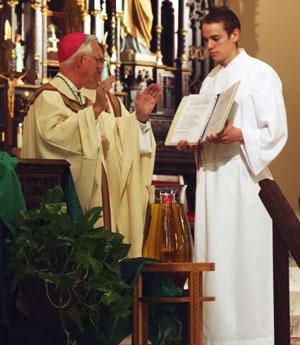
By Deacon Frank Agnoli
From Nov. 16-19, the U.S. bishops will be meeting together in Baltimore. Among the items they will be discussing are the last sections of prayers for the Mass being translated from Latin into English. A project that began decades ago is finally coming to an end, and once all the new translations are approved by Rome, we will begin the process of preparing ourselves to use the new texts.
In order to understand what’s happening this month, we need to step back for a moment and go over a little history.
After the Second Vatican Council, which met between 1962 and 1965, the way we celebrated Mass changed. The book that the priest uses at Mass —that contains both instructions on what to do and how to do it, as well as the prayers to be said — was extensively revised. For the first time, it also had to be translated from Latin into vernacular languages (such as English).
The first Latin edition of this new Missal came out in 1970; the English version came out in 1974. Within a year, we had a second edition in Latin; a decade later we had the Missal (or sacramentary) that we use now: the 1985 English edition. Almost immediately, those in charge of the translation process knew that it could be improved — so they began a process of revisiting the texts and re-translating them as well as studying the structure of the Mass and suggesting ways that it, too, could be adjusted.
So that’s the first reason why we are getting a new Missal. Even from the start, the intention was that the first translations were temporary. The church had never before undertaken such an extensive process of translation and church leaders knew that they were learning as they went along and that the texts could be improved. During the 40 years after the Council, translators learned a great deal about how liturgical language works and what different approaches to translation have to offer.
While they finished in 1998, this new version was never approved because the rules for translation had changed. The original translations used a principle called “dynamic equivalence,” but the new translation is being done according to the principle of “formal correspondence.”
Basically, the new translations will follow the Latin words and syntax (sentence structure) more closely, though not “slavishly” as some have suggested. As a result, what we will hear will sound more formal or poetic.
We see the same issues in translating the Bible — the New American Bible, New Revised Standard Version and New International Version are on the “formal correspondence” side of the spectrum; Today’s English Version, the New English Bible and the Jerusalem Bible are examples of translations using “dynamic equivalence.”
At the same time, since 2000, we have had a third edition of the Missal in Latin. So that’s a third reason why we are getting a new Missal: prayers have been added, new saints are being celebrated, and adjustments have been made to some of the details of how the Triduum is observed. But — and this is important — the way that we celebrate the Mass is staying the same. We are adding texts and translating them differently; we are not changing the Mass.
So, how are we going to make the move from what we are using now to new liturgical books? Among the critiques of the liturgical changes that occurred after Vatican II is that it took many Catholics by surprise. In a large number of parishes, there was no catechesis; the people were not helped to understand what was happening and why. The U.S. bishops are adamant that we need to do much better this time around.
Right now, until the texts are approved, we are in a time of “remote preparation,” laying the groundwork for when the texts are finally approved. For example, last week, the clergy and lay liturgical leaders from around the diocese had the opportunity to listen to Father Paul Turner — a pastor from Missouri and noted liturgist intimately involved in the translation process — speak on the new Missal (see accompanying article, "Priest’s explanation sets aside fears about Missal").
We have also built a page on the diocesan Web site dedicated to the New Missal: www.davenportdiocese.org/lit/litromanmissal.htm. Not only does our Web page link to the U.S. bishop’s site (www.usccb.org/romanmissal), but it contains a number of other resources as well.
In addition, I am beginning this series in The Messenger. Through this column, I hope to explain how the translation process works, highlight the strengths of the new translation (what it is that we are gaining), and acknowledge (and respond to) the concerns that some have raised. I will also introduce the texts that have already been approved (what is called the Order of the Mass — those things we say at each Eucharist) and try to explain what is changing and why.
Far from being the “pastoral disaster” that Bishop Donald Trautman fears it will be (Catholic Messenger, 10/29/09, Page 6), the new Missal is a golden opportunity to grow in our appreciation and love for the liturgy, to understand it more deeply and engage it more intentionally, and to continue the reforms called for by Vatican II. We’ll be fine, as long as we undertake this journey together in humility, gratitude, patience and charity.
Next time: The language of liturgy and the process of translation.
(Deacon Agnoli is director of liturgy and deacon formation for the Diocese of Davenport.)








